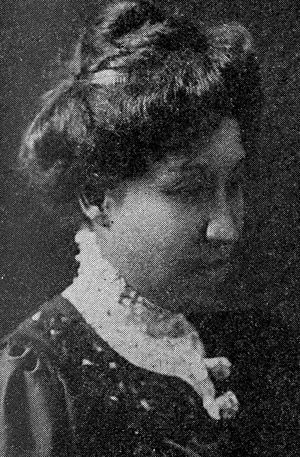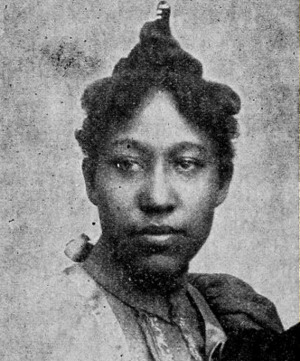Harriet Gibbs Marshall facts for kids
Quick facts for kids
Harriet Gibbs Marshall
|
|
|---|---|

1936 photo
|
|
| Born | 1868 |
| Died | February 21, 1941 Washington, D.C.
|
| Resting place | Lincoln Memorial Cemetery |
| Nationality | Canadian-born African American |
| Alma mater | Oberlin Conservatory of Music in Oberlin, Ohio |
| Occupation | pianist, writer, educator founder of Washington Conservatory of Music and School of Expression |
| Spouse(s) | Napoleon Bonaparte Marshall (married 1906) |
| Parent(s) | Mifflin Wistar Gibbs Maria Ann Alexander Gibbs |
| Relatives | Sister, Ida Alexander Gibbs |
Harriet Gibbs Marshall (1868 – February 21, 1941) was an American pianist, writer, and music teacher. She is famous for starting the Washington Conservatory of Music and School of Expression in 1903 in Washington, D.C.
Contents
Early Life and Family
Harriet Aletha Gibbs was born in Victoria, British Columbia. Her father, Mifflin Wistar Gibbs, was a lawyer in Little Rock, Arkansas. He later became the first African-American city judge in the United States. Her mother, Maria Ann Alexander, was a school teacher who graduated from Oberlin College.
Harriet's father moved to Victoria, Canada, from California. He left during the Gold Rush because of unfair rules that made Black people wear special badges. He raised Harriet and her sister, Ida Alexander Gibbs, in Victoria. Harriet and Ida started piano lessons when Harriet was nine years old. Ida also became a teacher after graduating from Oberlin.
Education and Musical Training
Harriet began studying at the Oberlin Conservatory when she was just eleven years old. She was still in high school at the time. She finished high school at fifteen and then started college at Oberlin.
In 1889, Harriet Gibbs made history. She became the first African-American woman to earn a Bachelor of Music degree in piano performance from Oberlin Conservatory. Oberlin was mostly a white school, but it was one of the first to accept Black students. After Oberlin, Harriet continued to study piano in Boston, Chicago, and Paris.
Music Career and Teaching
In the late 1800s, Harriet Gibbs was mentioned in newspapers in Saint Paul, Minnesota. She was known for teaching music and was called Hattie A. Gibbs. By 1891, she started the music program at Eckstein-Norton University in Kentucky. In 1894, Gibbs performed a piano recital in Little Rock, Arkansas, for an audience that included both Black and white people.
Moving to Washington, D.C.
In 1900, Gibbs started appearing in Washington, D.C., newspapers. She was noted as the first Black graduate of Oberlin. In January 1902, she gave recitals that received praise. She also spoke at the Bethel Literary and Historical Society, an important Black institution in D.C. She then became a music supervisor in the public schools there. At that time, schools were separated by race.
In May 1903, she presented a school musical for Washington Normal School. On October 1, 1903, she founded the Washington Conservatory of Music. This school focused on teaching classical European music.
Growing the Conservatory
Harriet Gibbs continued her work in public schools. In May 1904, she presented the school choir at Armstrong Normal School. In November, she worked with composer Samuel Coleridge-Taylor at M Street High School. By Spring 1905, the Conservatory had over 160 students.
That fall, Gibbs was named director of music for the Black schools in D.C. She was also president of the Conservatory. In September, Gibbs and friends traveled to Europe, visiting London, Paris, and the French countryside. Her sister, Ida Hunt, joined them. After her nine-month trip, Harriet noted that Black students were welcomed in German and French music schools. She mentioned Hazel Harrison who had recently performed with the Berlin Philharmonic Orchestra.
In Spring 1906, Harriet married Napoleon Bonaparte Marshall. He was a graduate of Harvard University and Harvard Law School. After getting married, she resigned from her public school job, as was common then. However, her resignation was not accepted at first, despite support from many people.
Washington Conservatory of Music and School of Expression
In Fall 1906, the Conservatory began advertising as the Washington Conservatory of Music and School of Expression. It had 14 teachers. Newspapers reported that the school had taught over 600 students since 1903. In 1909, Marshall's sister, Ida Gibbs Hunt, and their father stayed with Marshall for the winter.
In 1910, Illinois politician Martin B. Madden handed out diplomas to the Conservatory graduates. In 1911, the school advertised in The Crisis magazine. Marshall also traveled to promote the school. The Pittsburgh Courier reported that the school was unique because it welcomed students of all races and genders. It had taught about 1,400 students by then. The school also offered scholarships.
In 1912, Marshall joined the Baháʼí Faith. She hosted Baháʼí events at the Conservatory. That winter, the Conservatory put on a play called The Mikado at the Howard Theater. The next spring, the Conservatory held a performance where many of the songs were written by the students themselves.
In July 1915, Marshall's father, Judge Mifflin W. Gibbs, passed away at 93. In October 1915, Marshall helped with the music for The Star of Ethiopia. This was a play by W. E. B. Du Bois that showed Black history. In August 1916, Marshall presented a program on "Negro Folk Songs" in Hot Springs, Arkansas.
In 1920, Marshall started a plan to raise money for a national music school. This school would include Black music. In April 1921, the Conservatory held a fundraiser in New York. It featured "negro music and drama." Marshall continued to work for a national conservatory in April 1922. She brought together many leaders in Black music. Famous conductor Walter Damrosch supported the idea.
Time in Haiti
In the mid-1920s, Marshall moved to Haiti. Her husband, Captain Marshall, was sent there to investigate problems during the United States occupation of Haiti. While in Haiti, the Marshalls faced racial segregation and were excluded from social events with other U.S. military officers.
Marshall became involved with Haitian groups. She was Vice-President of the Organization of Haitian Women. She also helped start the Jean Joseph Industrial School and raised money for it in the United States. When the Marshalls returned to the U.S., they formed the Save Haiti Committee. This group worked to convince President Herbert Hoover to remove U.S. soldiers from Haiti. In 1930, Marshall published a book called The Story of Haiti: from the discovery of the island by Christopher Columbus to the present day.
Later Writings and Recognition
In 1932, Marshall wrote a poem called Brotherhood. It was published in the Baháʼí news magazine Star of the West. By 1934, Marshall was again recognized as the director of the Conservatory.
In 1936, Marshall wrote a musical play called The Last Concerto. It was based on the life and music of Samuel Coleridge-Taylor. In 1939, Marshall was one of four artists honored at the National Association of Negro Musicians.
Death and Legacy
Harriet Gibbs Marshall passed away on February 21, 1941, in Washington, D.C. She left all her money and belongings to the Washington Conservatory. Her work helped many students learn music and promoted the importance of Black music and culture.


